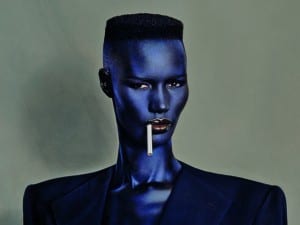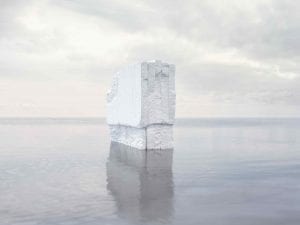A terrella – Latin for “Little Earth” – is a small, magnetised ball that serves as a model of our planet. It is believed to have been invented in by physicist William Gilbert (1544-c.1603), who is famous for his pioneering studies into the Earth’s magnetism published in his book De Magnete (1600). Now, French visual artist Noémie Goudal (b. 1984) applies the name to an installation composed of 15 sculptures that interpret theories about the earth’s creation and shape from antiquity until today. This fascinating project will be on display amongst other exciting pieces in Goudal’s upcoming show at Mostyn Gallery, Llandudno. The exhibition is called Contours of Certainty and it expands on her interests in doubt, illusion and scientific exploration. In 2015, Goudal was longlisted for the Aesthetica Art Prize and has gone on to exhibit at prestigious institutions around the world, from the V&A to Centre Pompidou. Now, she is a nominee for the Marcel Duchamp Prize 2024. We caught up with Goudal to learn more about Contours of Certainty, from her work with a historian of science to the ways she has used the building’s unique space.


A: The power of doubt is a concept you have explored throughout your practice and this continues into your exhibition at Mostyn. What are your current reflections on doubt?
NG: For me, doubt mainly relates to our relationship with science and how this subject has developed over time. The trajectory we went through – from antiquity to the Middle Ages and the Renaissance – has led us to the science we have now, which is built on many hypotheses and reflections on how the Earth was formed. I find it really interesting, despite whether the hypotheses and theories are true or not. I’m interested in the journey that has brought us to where we are now. What I love is that these hypotheses and theories exist within their own contexts: the religious, social, and scientific contexts of their time. They provide a very different viewpoint on the relationship with nature and the landscape in general.
As a child, I believed something to be real or a fact if it was written in my geography or history book. Today, I talk to researchers who publish meaningful findings in reviews like Nature. However, a year later, another scientist might propose a theory that challenges and potentially collapses the first one. What I like about this is that contemporary studies are very much still on an expedition; they are immersed in doubt. This ongoing search is why I love working with researchers, as it provides inspiration and highlights that this field is still a pursuit.
A: It’s exciting to hear that you will be presenting viewers with some of your newest projects. Could you give us an introduction to some of these?
NG: The newest project of the whole show is a series called White Pulse. I’ve worked with five layers of photographs that I printed and placed in front of my camera. These are pictures of very rocky mountain landscapes. I printed one image five times, one after the other, and then cut and curved them to create a sort of anamorphic installation. This placement makes them look like they have a curvature of space and, with the shadow of the paper, it creates a space that doesn’t exist in the real landscape. It’s almost like a layer of space that could potentially exist within those real geographical spaces.
This piece was inspired by Mount Analogue, a novel written by René Daumal in 1942. The plot follows a group of people trying to find Mount Analogue, a mountain that you can only access through one possible curvature of space. This novel is heavily inspired by scientific theories such as the string theory. For me, it was interesting to explore how there are many ways to look at our planet and landscape. There are the landscapes you can see with your eyes, and then there are features and places within them that you can’t necessarily see or feel but they may exist in different forms. That’s what this piece is about for me.


A: On display is Terrella, an installation composed of varying stacked sculptures. Could you tell us more about this artwork?
NG: The Terrella installation consists of 15 sculptures that I created at the Manufacture nationale de Sèvres, a renowned European porcelain manufacturer. Each sculpture represents a different theory of the Earth throughout history. I collaborated with a historian of science, focusing on the period from antiquity until now, to explore the most significant theories, including those of Aristotle, Plato, Buffon, and Newton. Each had their own perspective on the planet’s creation and its geological relief.
My inspiration began with a piece from the Musée des Arts et Métiers in France, dating back to the 19th century. Working closely with the historian, I delved into these theories, sketched out ideas, and then partnered with Sèvres to bring these sculptures to life. They will be displayed together in the upcoming exhibition.
A: Contours of Certainty takes over Mostyn. How did you make use of the building’s unique architecture for this show?
NG: What I really loved in the galleries at Mostyn is the way light comes through the ceiling. It reminded me of the approach I took when working on my latest films. I often shoot in spaces with skylights like that, positioning my camera at one end of the studio. I arrange my paper backdrops in front of the camera and sequence them to burn one after another. This technique is evident in a film I worked on a few years ago called Below the Deep South (2021). Here, layers of paper burn sequentially. However, before everything is engulfed in flames, one can see these layers stacked one after another. The quality of light from above is fundamental; it allows these paper backdrops to be fully visible. That’s why I have aimed to recreate a similar principle in this space.
Here I am using a material similar to tracing paper, but slightly thicker, to create additional layers in the two gallery spaces. This fabric cascades from the ceiling and divides the galleries in a way that reveals and obstructs the artworks at the same time. One can see the edge of the porcelain sculpture while looking at the back of the frame that’s hung on top of the semi-transparent drape. The overhead lighting is instrumental in this installation, and I had so much freedom to create a visitor path in a way that all the sculptures and the photographs could be lit very well at the same time.


A: Is there a particular idea or feeling you wish for visitors to take away after experiencing this exhibition?
NG: I think the most important aspect of the exhibition experience, for me, is the variety of ways one can interpret the work. I always bring extensive research to each project, particularly focusing here on the history of science and the history of uncertainties—things we didn’t know and still don’t. What I want from my shows is that viewers can bring their own interpretations to the work. If someone wants to explore the scientific aspects, they can, but it’s not required. There are multiple layers to delve into, especially in the imagery and photographs. I always provide keys to different readings within my work. For example, you might notice tapes, ropes and similar elements. In the White Pulse series I mentioned earlier you can also see clips holding the paper. These elements are part of what the viewer can use to construct their own impression of the work.
Mostyn, Noémie Goudal: Contours of Certainty | Until 7 September
Image Credits:
- Noémie Goudal, Observatoire II (Dome), 2013. © Noemie Goudal. Courtesy the artist and Edel Assanti. Photo by Noemie Goudal’s studio.
- Noémie Goudal, Soulevement II, 2018. © Noemie Goudal. Courtesy the artist and Edel Assanti.Photo by Noemie Goudal’s studio.
- Noémie Goudal, Les Enfers de Dante, 2023. © Noémie Goudal. Courtesy of Edel Assanti. Photo by Noemie Goudal’s studio.
- Noemie Goudal, Prendre le soleil, installation view, Hangar Y, Meudon, France © Noemie Goudal. Courtesy of Hangar Y. Photo by Aurélien Mole 4.
- Noémie Goudal, White Pulse I, 2023.© Noemie Goudal. Courtesy the artist and Edel Assanti. Photo by Noemie Goudal’s studio.
- Noémie Goudal, Soulevement I, 2018. © Noemie Goudal. Courtesy the artist and Edel Assanti.Photo by Noemie Goudal’s studio.





